Legal Risk Management: Risks and Mitigation Strategies for VDP Project
VerifiedAdded on 2021/06/17
|12
|2849
|26
Report
AI Summary
This report provides a detailed analysis of legal risk management within the Victorian Desalination Plant (VDP) project, a Public Private Partnership (PPP). It identifies inherent legal risks across the pre-construction, construction, and operational phases, including non-compliance with the EPBC Act, design errors, project delays and cost overruns, labor disputes, changes in laws and regulations, and health and safety concerns. The report outlines potential consequences for both the contracting party (government) and the contractor (Aqua Sure Company). Furthermore, the report suggests control measures to mitigate these risks, such as conducting thorough site assessments, implementing sectional completion processes, and ensuring proper labor management. It also explores various dispute resolution approaches, including Dispute Adjudication Boards (DAB), Dispute Review Boards (DRB), and Combined Dispute Boards (CDB), highlighting their key features and mandates. The report emphasizes the importance of proactive risk management and effective dispute resolution to ensure the successful completion and operation of the VDP project.
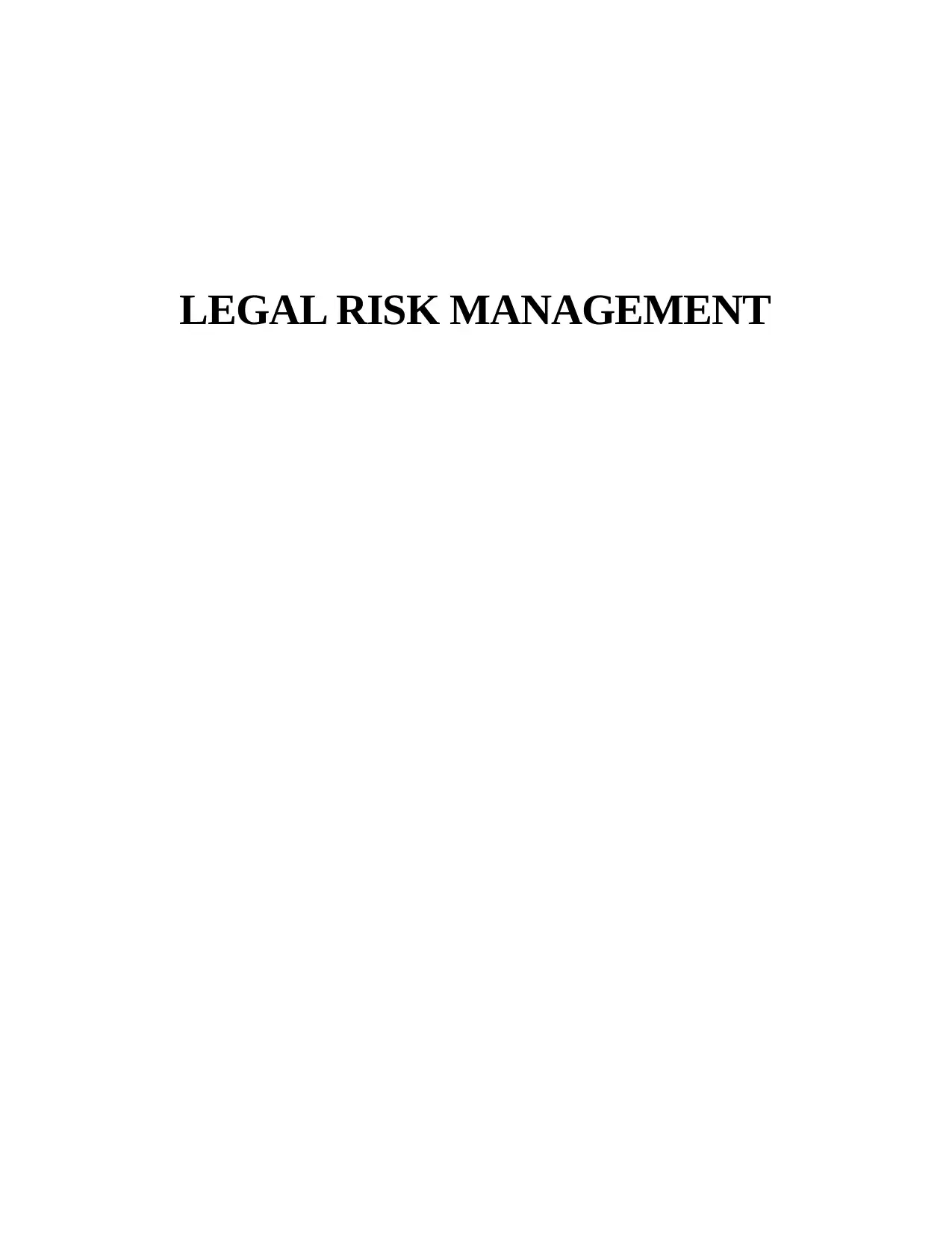
LEGAL RISK MANAGEMENT
Paraphrase This Document
Need a fresh take? Get an instant paraphrase of this document with our AI Paraphraser
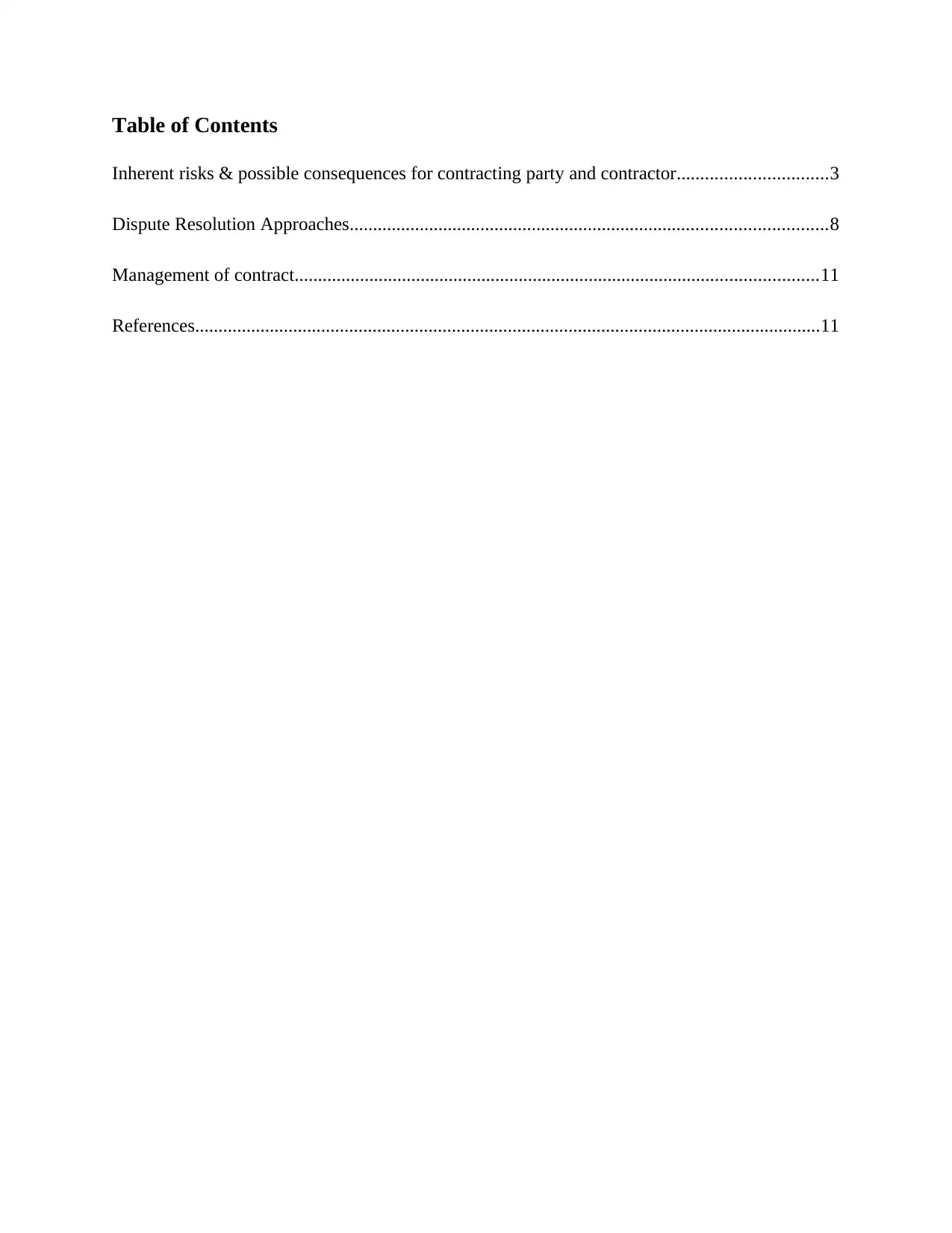
Table of Contents
Inherent risks & possible consequences for contracting party and contractor................................3
Dispute Resolution Approaches......................................................................................................8
Management of contract................................................................................................................11
References......................................................................................................................................11
Inherent risks & possible consequences for contracting party and contractor................................3
Dispute Resolution Approaches......................................................................................................8
Management of contract................................................................................................................11
References......................................................................................................................................11
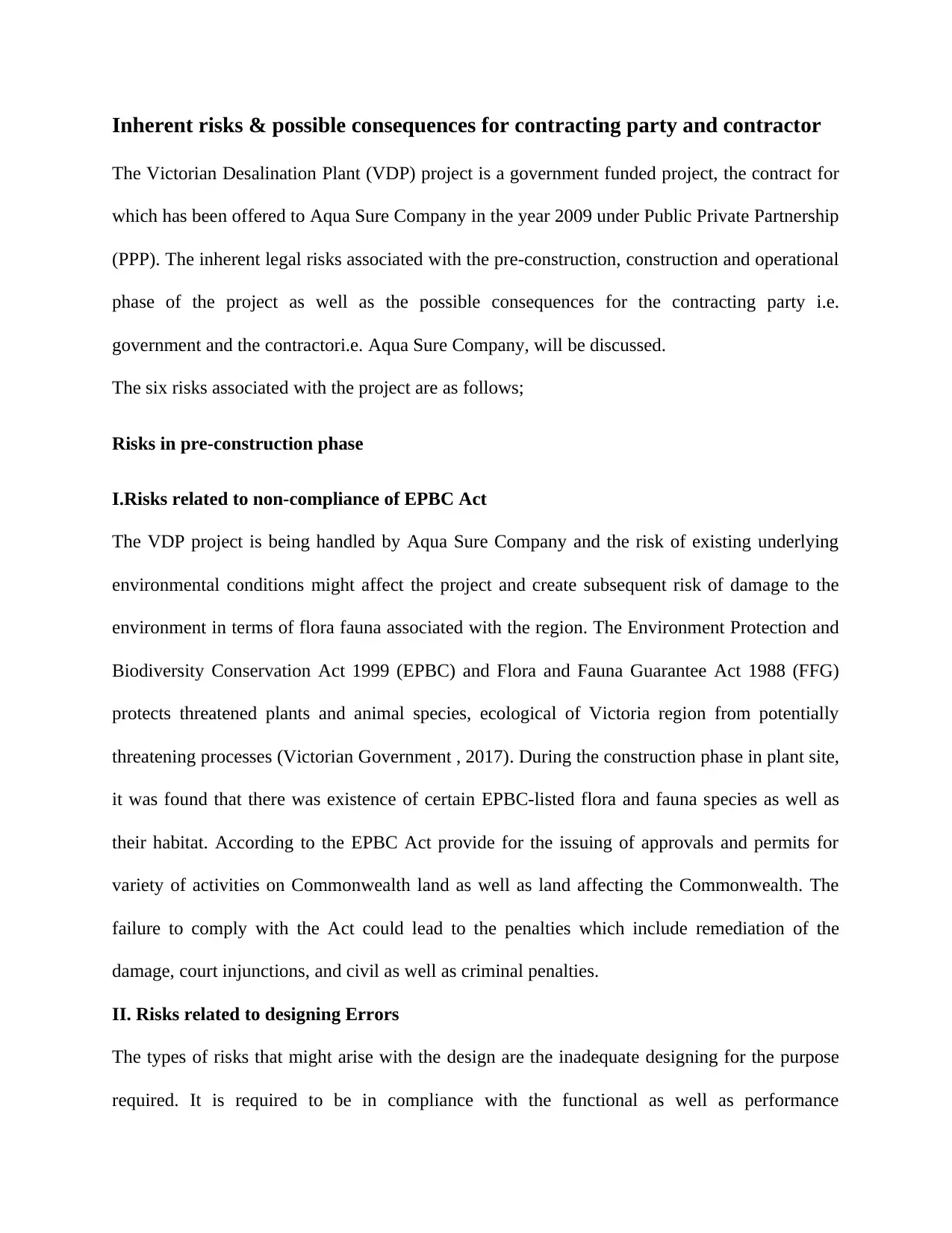
Inherent risks & possible consequences for contracting party and contractor
The Victorian Desalination Plant (VDP) project is a government funded project, the contract for
which has been offered to Aqua Sure Company in the year 2009 under Public Private Partnership
(PPP). The inherent legal risks associated with the pre-construction, construction and operational
phase of the project as well as the possible consequences for the contracting party i.e.
government and the contractori.e. Aqua Sure Company, will be discussed.
The six risks associated with the project are as follows;
Risks in pre-construction phase
I.Risks related to non-compliance of EPBC Act
The VDP project is being handled by Aqua Sure Company and the risk of existing underlying
environmental conditions might affect the project and create subsequent risk of damage to the
environment in terms of flora fauna associated with the region. The Environment Protection and
Biodiversity Conservation Act 1999 (EPBC) and Flora and Fauna Guarantee Act 1988 (FFG)
protects threatened plants and animal species, ecological of Victoria region from potentially
threatening processes (Victorian Government , 2017). During the construction phase in plant site,
it was found that there was existence of certain EPBC-listed flora and fauna species as well as
their habitat. According to the EPBC Act provide for the issuing of approvals and permits for
variety of activities on Commonwealth land as well as land affecting the Commonwealth. The
failure to comply with the Act could lead to the penalties which include remediation of the
damage, court injunctions, and civil as well as criminal penalties.
II. Risks related to designing Errors
The types of risks that might arise with the design are the inadequate designing for the purpose
required. It is required to be in compliance with the functional as well as performance
The Victorian Desalination Plant (VDP) project is a government funded project, the contract for
which has been offered to Aqua Sure Company in the year 2009 under Public Private Partnership
(PPP). The inherent legal risks associated with the pre-construction, construction and operational
phase of the project as well as the possible consequences for the contracting party i.e.
government and the contractori.e. Aqua Sure Company, will be discussed.
The six risks associated with the project are as follows;
Risks in pre-construction phase
I.Risks related to non-compliance of EPBC Act
The VDP project is being handled by Aqua Sure Company and the risk of existing underlying
environmental conditions might affect the project and create subsequent risk of damage to the
environment in terms of flora fauna associated with the region. The Environment Protection and
Biodiversity Conservation Act 1999 (EPBC) and Flora and Fauna Guarantee Act 1988 (FFG)
protects threatened plants and animal species, ecological of Victoria region from potentially
threatening processes (Victorian Government , 2017). During the construction phase in plant site,
it was found that there was existence of certain EPBC-listed flora and fauna species as well as
their habitat. According to the EPBC Act provide for the issuing of approvals and permits for
variety of activities on Commonwealth land as well as land affecting the Commonwealth. The
failure to comply with the Act could lead to the penalties which include remediation of the
damage, court injunctions, and civil as well as criminal penalties.
II. Risks related to designing Errors
The types of risks that might arise with the design are the inadequate designing for the purpose
required. It is required to be in compliance with the functional as well as performance
⊘ This is a preview!⊘
Do you want full access?
Subscribe today to unlock all pages.

Trusted by 1+ million students worldwide

specification as provided by the government. In addition, it should follow the construction
standards of Australia. After the finalization of the design, it is verified and approved by the
contracting authority. In case of errors during the construction phase, the risk of liability arises
on both the parties to the contract, equally as both have approved the designed with their mutual
consent.
Risks in construction phase
III. Risks related to delay & cost-overrun
During the construction phase, the completion of project related risks such as delay in
completion of construction of plant or cost overrun, which becomes time consuming as well as
financial loss due to extra costs incurred in the completion as planned in the budget. Under the
contract, the provision of liquidated damages accounts for the damages caused due to
inexcusable delays in the project beyond the date of completion of construction process. In this
context, inexcusable delays are considered as contractor caused delays or the delays caused due
to the risks as accepted by the contractor under the contract (Crepin & Aversa, 2018). The
provision of liquidated damages is standard and enforceable by calculating the actual pre-
estimate of the related loss. The contractor will be held responsible for delay and cost overrun
and they will have to suffer loss of expected revenue, ongoing costs of financing the construction
of plant as well as extended costs of site.
IV. Risks related to labor disputes
During construction phase, the issues of labor disputes usually arise and the conflicts might be
general or political in nature. The responsible authority for this risk would be the contractor as
the management of labor is considered as the responsibility of the contractor. The allocation of
standards of Australia. After the finalization of the design, it is verified and approved by the
contracting authority. In case of errors during the construction phase, the risk of liability arises
on both the parties to the contract, equally as both have approved the designed with their mutual
consent.
Risks in construction phase
III. Risks related to delay & cost-overrun
During the construction phase, the completion of project related risks such as delay in
completion of construction of plant or cost overrun, which becomes time consuming as well as
financial loss due to extra costs incurred in the completion as planned in the budget. Under the
contract, the provision of liquidated damages accounts for the damages caused due to
inexcusable delays in the project beyond the date of completion of construction process. In this
context, inexcusable delays are considered as contractor caused delays or the delays caused due
to the risks as accepted by the contractor under the contract (Crepin & Aversa, 2018). The
provision of liquidated damages is standard and enforceable by calculating the actual pre-
estimate of the related loss. The contractor will be held responsible for delay and cost overrun
and they will have to suffer loss of expected revenue, ongoing costs of financing the construction
of plant as well as extended costs of site.
IV. Risks related to labor disputes
During construction phase, the issues of labor disputes usually arise and the conflicts might be
general or political in nature. The responsible authority for this risk would be the contractor as
the management of labor is considered as the responsibility of the contractor. The allocation of
Paraphrase This Document
Need a fresh take? Get an instant paraphrase of this document with our AI Paraphraser
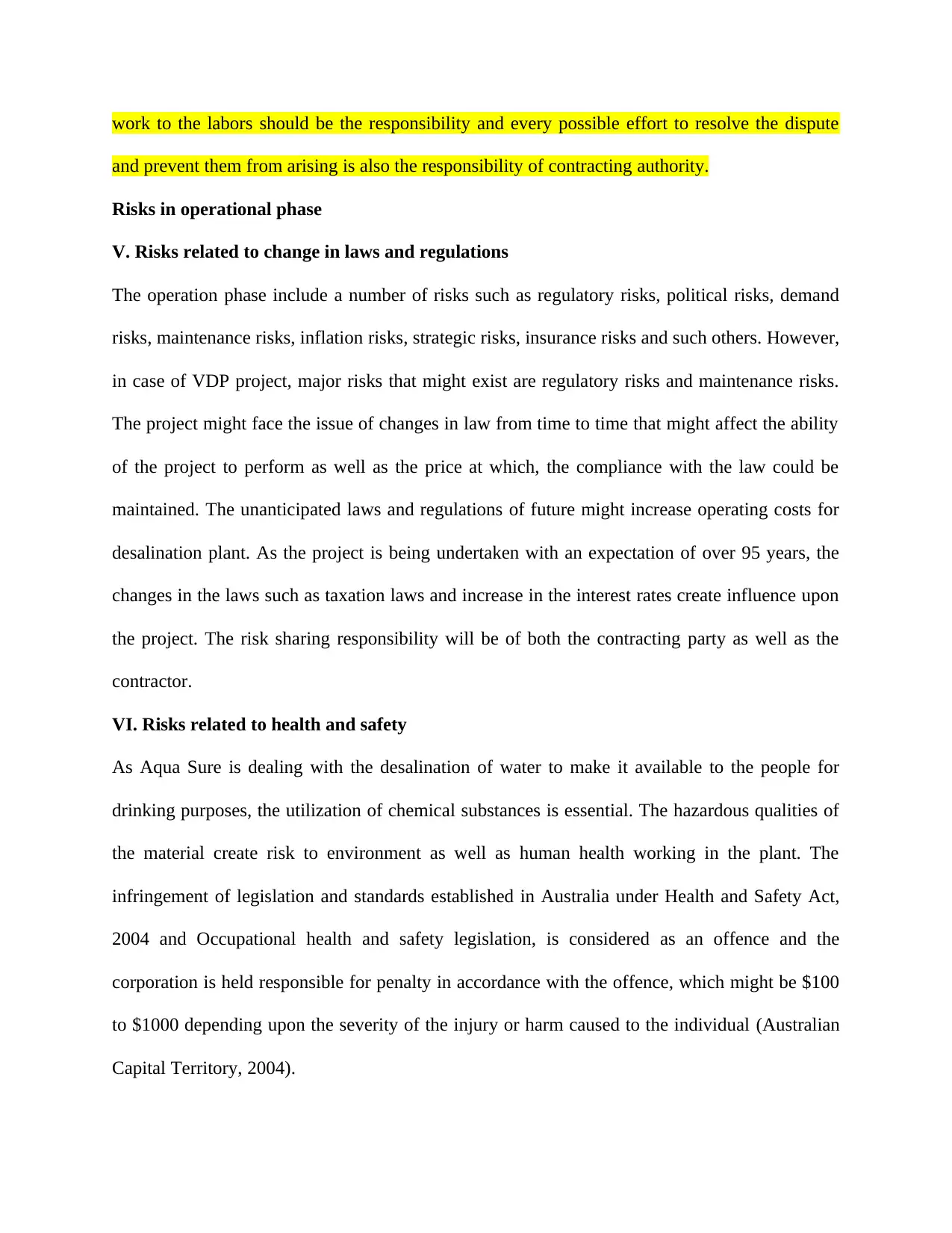
work to the labors should be the responsibility and every possible effort to resolve the dispute
and prevent them from arising is also the responsibility of contracting authority.
Risks in operational phase
V. Risks related to change in laws and regulations
The operation phase include a number of risks such as regulatory risks, political risks, demand
risks, maintenance risks, inflation risks, strategic risks, insurance risks and such others. However,
in case of VDP project, major risks that might exist are regulatory risks and maintenance risks.
The project might face the issue of changes in law from time to time that might affect the ability
of the project to perform as well as the price at which, the compliance with the law could be
maintained. The unanticipated laws and regulations of future might increase operating costs for
desalination plant. As the project is being undertaken with an expectation of over 95 years, the
changes in the laws such as taxation laws and increase in the interest rates create influence upon
the project. The risk sharing responsibility will be of both the contracting party as well as the
contractor.
VI. Risks related to health and safety
As Aqua Sure is dealing with the desalination of water to make it available to the people for
drinking purposes, the utilization of chemical substances is essential. The hazardous qualities of
the material create risk to environment as well as human health working in the plant. The
infringement of legislation and standards established in Australia under Health and Safety Act,
2004 and Occupational health and safety legislation, is considered as an offence and the
corporation is held responsible for penalty in accordance with the offence, which might be $100
to $1000 depending upon the severity of the injury or harm caused to the individual (Australian
Capital Territory, 2004).
and prevent them from arising is also the responsibility of contracting authority.
Risks in operational phase
V. Risks related to change in laws and regulations
The operation phase include a number of risks such as regulatory risks, political risks, demand
risks, maintenance risks, inflation risks, strategic risks, insurance risks and such others. However,
in case of VDP project, major risks that might exist are regulatory risks and maintenance risks.
The project might face the issue of changes in law from time to time that might affect the ability
of the project to perform as well as the price at which, the compliance with the law could be
maintained. The unanticipated laws and regulations of future might increase operating costs for
desalination plant. As the project is being undertaken with an expectation of over 95 years, the
changes in the laws such as taxation laws and increase in the interest rates create influence upon
the project. The risk sharing responsibility will be of both the contracting party as well as the
contractor.
VI. Risks related to health and safety
As Aqua Sure is dealing with the desalination of water to make it available to the people for
drinking purposes, the utilization of chemical substances is essential. The hazardous qualities of
the material create risk to environment as well as human health working in the plant. The
infringement of legislation and standards established in Australia under Health and Safety Act,
2004 and Occupational health and safety legislation, is considered as an offence and the
corporation is held responsible for penalty in accordance with the offence, which might be $100
to $1000 depending upon the severity of the injury or harm caused to the individual (Australian
Capital Territory, 2004).
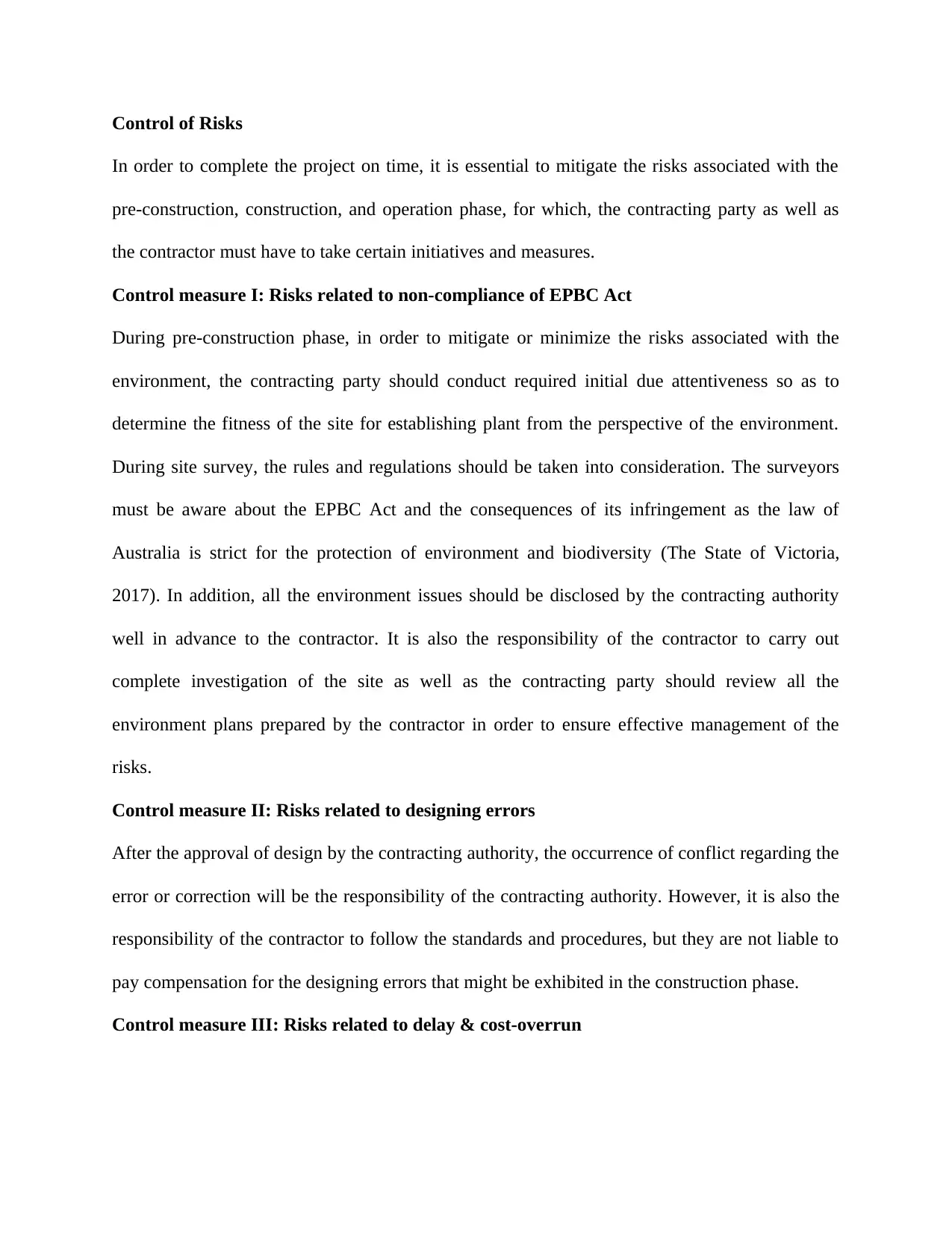
Control of Risks
In order to complete the project on time, it is essential to mitigate the risks associated with the
pre-construction, construction, and operation phase, for which, the contracting party as well as
the contractor must have to take certain initiatives and measures.
Control measure I: Risks related to non-compliance of EPBC Act
During pre-construction phase, in order to mitigate or minimize the risks associated with the
environment, the contracting party should conduct required initial due attentiveness so as to
determine the fitness of the site for establishing plant from the perspective of the environment.
During site survey, the rules and regulations should be taken into consideration. The surveyors
must be aware about the EPBC Act and the consequences of its infringement as the law of
Australia is strict for the protection of environment and biodiversity (The State of Victoria,
2017). In addition, all the environment issues should be disclosed by the contracting authority
well in advance to the contractor. It is also the responsibility of the contractor to carry out
complete investigation of the site as well as the contracting party should review all the
environment plans prepared by the contractor in order to ensure effective management of the
risks.
Control measure II: Risks related to designing errors
After the approval of design by the contracting authority, the occurrence of conflict regarding the
error or correction will be the responsibility of the contracting authority. However, it is also the
responsibility of the contractor to follow the standards and procedures, but they are not liable to
pay compensation for the designing errors that might be exhibited in the construction phase.
Control measure III: Risks related to delay & cost-overrun
In order to complete the project on time, it is essential to mitigate the risks associated with the
pre-construction, construction, and operation phase, for which, the contracting party as well as
the contractor must have to take certain initiatives and measures.
Control measure I: Risks related to non-compliance of EPBC Act
During pre-construction phase, in order to mitigate or minimize the risks associated with the
environment, the contracting party should conduct required initial due attentiveness so as to
determine the fitness of the site for establishing plant from the perspective of the environment.
During site survey, the rules and regulations should be taken into consideration. The surveyors
must be aware about the EPBC Act and the consequences of its infringement as the law of
Australia is strict for the protection of environment and biodiversity (The State of Victoria,
2017). In addition, all the environment issues should be disclosed by the contracting authority
well in advance to the contractor. It is also the responsibility of the contractor to carry out
complete investigation of the site as well as the contracting party should review all the
environment plans prepared by the contractor in order to ensure effective management of the
risks.
Control measure II: Risks related to designing errors
After the approval of design by the contracting authority, the occurrence of conflict regarding the
error or correction will be the responsibility of the contracting authority. However, it is also the
responsibility of the contractor to follow the standards and procedures, but they are not liable to
pay compensation for the designing errors that might be exhibited in the construction phase.
Control measure III: Risks related to delay & cost-overrun
⊘ This is a preview!⊘
Do you want full access?
Subscribe today to unlock all pages.

Trusted by 1+ million students worldwide
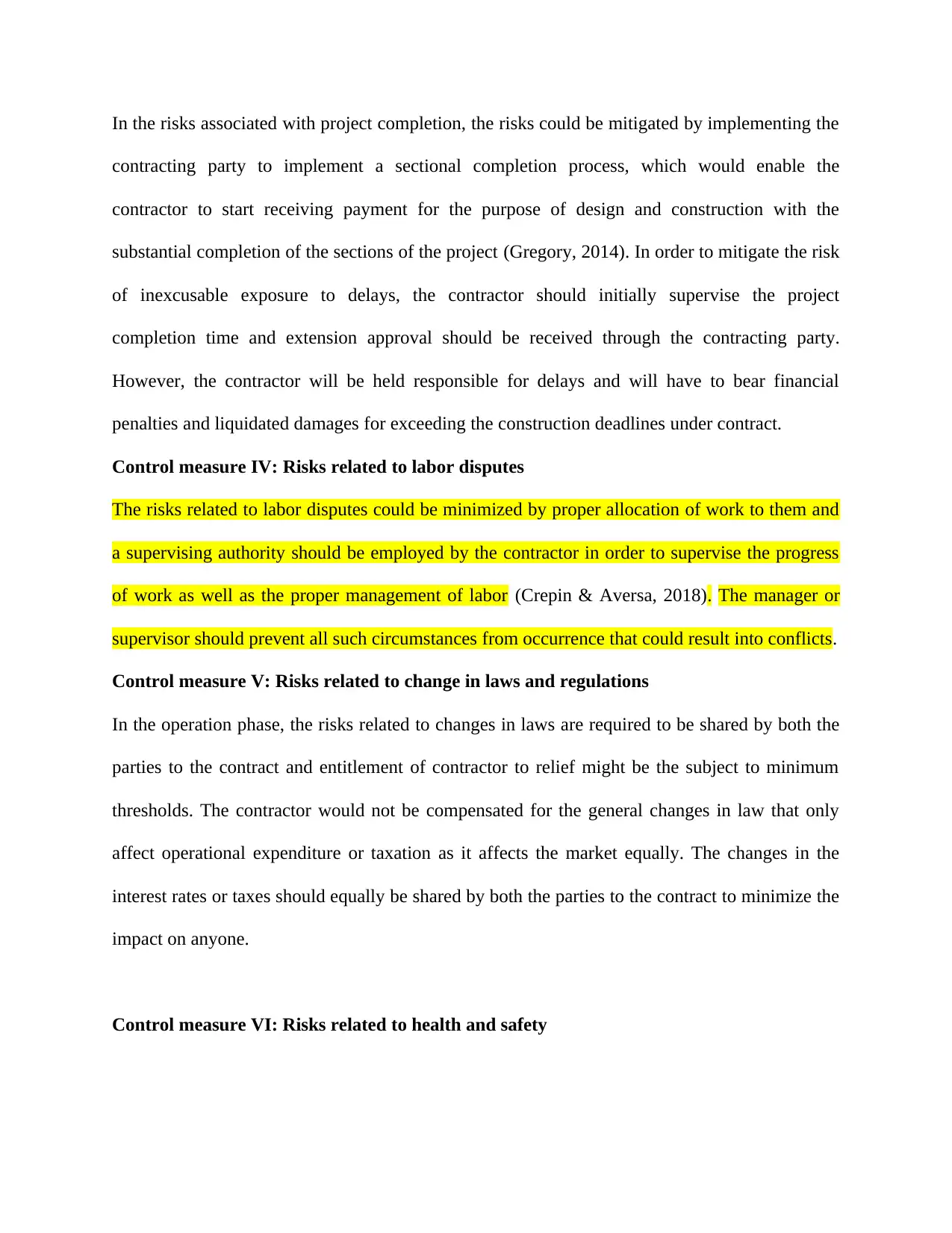
In the risks associated with project completion, the risks could be mitigated by implementing the
contracting party to implement a sectional completion process, which would enable the
contractor to start receiving payment for the purpose of design and construction with the
substantial completion of the sections of the project (Gregory, 2014). In order to mitigate the risk
of inexcusable exposure to delays, the contractor should initially supervise the project
completion time and extension approval should be received through the contracting party.
However, the contractor will be held responsible for delays and will have to bear financial
penalties and liquidated damages for exceeding the construction deadlines under contract.
Control measure IV: Risks related to labor disputes
The risks related to labor disputes could be minimized by proper allocation of work to them and
a supervising authority should be employed by the contractor in order to supervise the progress
of work as well as the proper management of labor (Crepin & Aversa, 2018). The manager or
supervisor should prevent all such circumstances from occurrence that could result into conflicts.
Control measure V: Risks related to change in laws and regulations
In the operation phase, the risks related to changes in laws are required to be shared by both the
parties to the contract and entitlement of contractor to relief might be the subject to minimum
thresholds. The contractor would not be compensated for the general changes in law that only
affect operational expenditure or taxation as it affects the market equally. The changes in the
interest rates or taxes should equally be shared by both the parties to the contract to minimize the
impact on anyone.
Control measure VI: Risks related to health and safety
contracting party to implement a sectional completion process, which would enable the
contractor to start receiving payment for the purpose of design and construction with the
substantial completion of the sections of the project (Gregory, 2014). In order to mitigate the risk
of inexcusable exposure to delays, the contractor should initially supervise the project
completion time and extension approval should be received through the contracting party.
However, the contractor will be held responsible for delays and will have to bear financial
penalties and liquidated damages for exceeding the construction deadlines under contract.
Control measure IV: Risks related to labor disputes
The risks related to labor disputes could be minimized by proper allocation of work to them and
a supervising authority should be employed by the contractor in order to supervise the progress
of work as well as the proper management of labor (Crepin & Aversa, 2018). The manager or
supervisor should prevent all such circumstances from occurrence that could result into conflicts.
Control measure V: Risks related to change in laws and regulations
In the operation phase, the risks related to changes in laws are required to be shared by both the
parties to the contract and entitlement of contractor to relief might be the subject to minimum
thresholds. The contractor would not be compensated for the general changes in law that only
affect operational expenditure or taxation as it affects the market equally. The changes in the
interest rates or taxes should equally be shared by both the parties to the contract to minimize the
impact on anyone.
Control measure VI: Risks related to health and safety
Paraphrase This Document
Need a fresh take? Get an instant paraphrase of this document with our AI Paraphraser
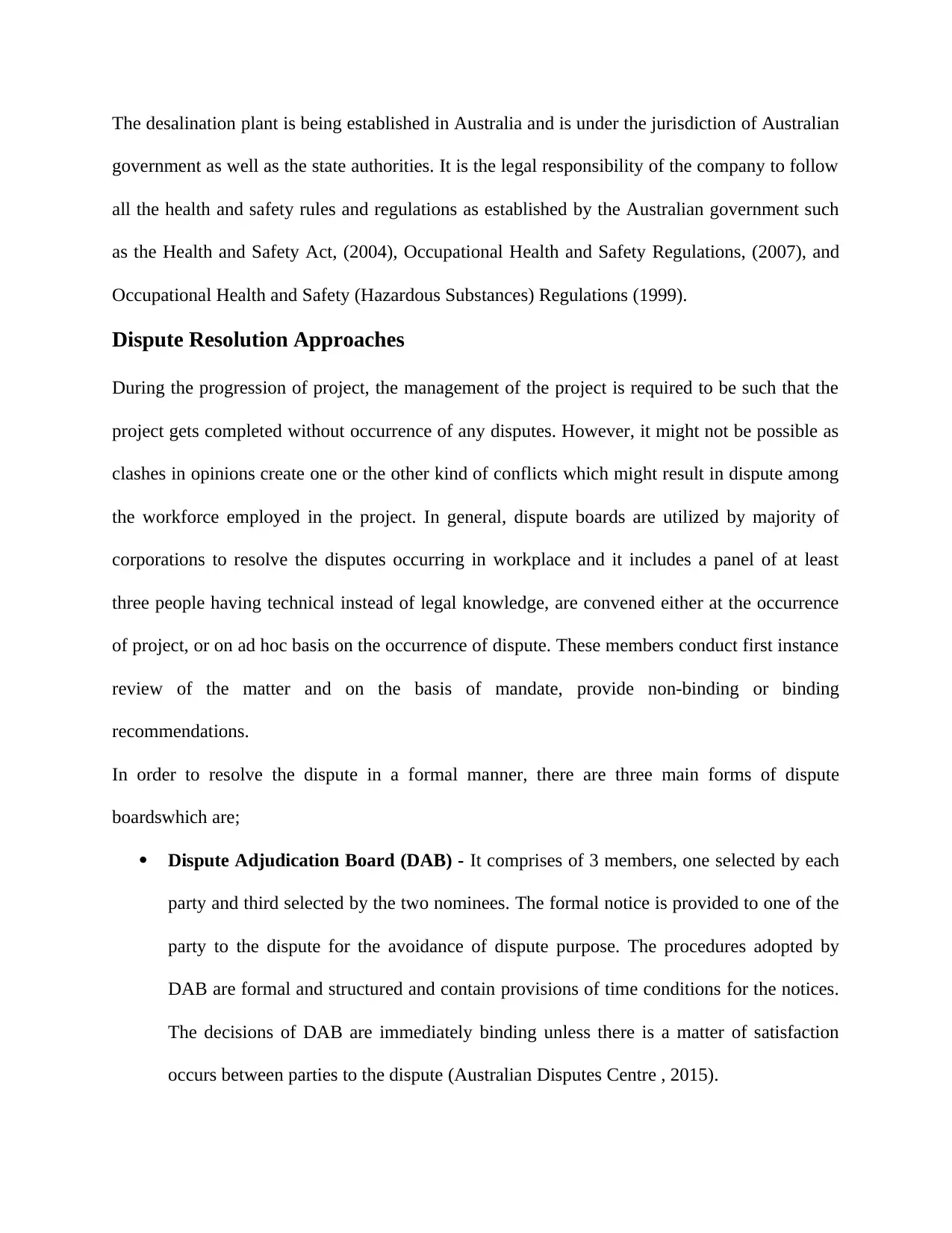
The desalination plant is being established in Australia and is under the jurisdiction of Australian
government as well as the state authorities. It is the legal responsibility of the company to follow
all the health and safety rules and regulations as established by the Australian government such
as the Health and Safety Act, (2004), Occupational Health and Safety Regulations, (2007), and
Occupational Health and Safety (Hazardous Substances) Regulations (1999).
Dispute Resolution Approaches
During the progression of project, the management of the project is required to be such that the
project gets completed without occurrence of any disputes. However, it might not be possible as
clashes in opinions create one or the other kind of conflicts which might result in dispute among
the workforce employed in the project. In general, dispute boards are utilized by majority of
corporations to resolve the disputes occurring in workplace and it includes a panel of at least
three people having technical instead of legal knowledge, are convened either at the occurrence
of project, or on ad hoc basis on the occurrence of dispute. These members conduct first instance
review of the matter and on the basis of mandate, provide non-binding or binding
recommendations.
In order to resolve the dispute in a formal manner, there are three main forms of dispute
boardswhich are;
Dispute Adjudication Board (DAB) - It comprises of 3 members, one selected by each
party and third selected by the two nominees. The formal notice is provided to one of the
party to the dispute for the avoidance of dispute purpose. The procedures adopted by
DAB are formal and structured and contain provisions of time conditions for the notices.
The decisions of DAB are immediately binding unless there is a matter of satisfaction
occurs between parties to the dispute (Australian Disputes Centre , 2015).
government as well as the state authorities. It is the legal responsibility of the company to follow
all the health and safety rules and regulations as established by the Australian government such
as the Health and Safety Act, (2004), Occupational Health and Safety Regulations, (2007), and
Occupational Health and Safety (Hazardous Substances) Regulations (1999).
Dispute Resolution Approaches
During the progression of project, the management of the project is required to be such that the
project gets completed without occurrence of any disputes. However, it might not be possible as
clashes in opinions create one or the other kind of conflicts which might result in dispute among
the workforce employed in the project. In general, dispute boards are utilized by majority of
corporations to resolve the disputes occurring in workplace and it includes a panel of at least
three people having technical instead of legal knowledge, are convened either at the occurrence
of project, or on ad hoc basis on the occurrence of dispute. These members conduct first instance
review of the matter and on the basis of mandate, provide non-binding or binding
recommendations.
In order to resolve the dispute in a formal manner, there are three main forms of dispute
boardswhich are;
Dispute Adjudication Board (DAB) - It comprises of 3 members, one selected by each
party and third selected by the two nominees. The formal notice is provided to one of the
party to the dispute for the avoidance of dispute purpose. The procedures adopted by
DAB are formal and structured and contain provisions of time conditions for the notices.
The decisions of DAB are immediately binding unless there is a matter of satisfaction
occurs between parties to the dispute (Australian Disputes Centre , 2015).
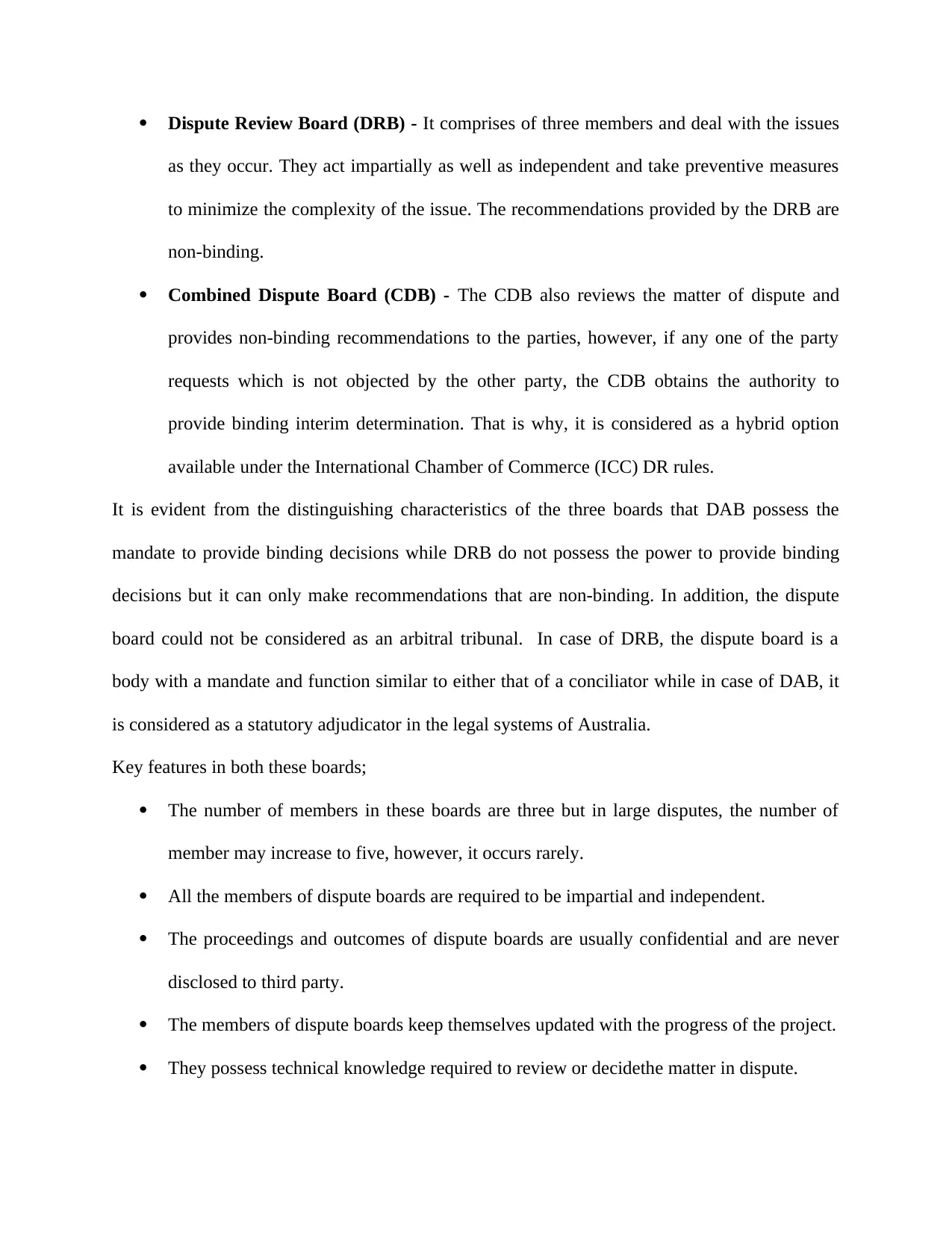
Dispute Review Board (DRB) - It comprises of three members and deal with the issues
as they occur. They act impartially as well as independent and take preventive measures
to minimize the complexity of the issue. The recommendations provided by the DRB are
non-binding.
Combined Dispute Board (CDB) - The CDB also reviews the matter of dispute and
provides non-binding recommendations to the parties, however, if any one of the party
requests which is not objected by the other party, the CDB obtains the authority to
provide binding interim determination. That is why, it is considered as a hybrid option
available under the International Chamber of Commerce (ICC) DR rules.
It is evident from the distinguishing characteristics of the three boards that DAB possess the
mandate to provide binding decisions while DRB do not possess the power to provide binding
decisions but it can only make recommendations that are non-binding. In addition, the dispute
board could not be considered as an arbitral tribunal. In case of DRB, the dispute board is a
body with a mandate and function similar to either that of a conciliator while in case of DAB, it
is considered as a statutory adjudicator in the legal systems of Australia.
Key features in both these boards;
The number of members in these boards are three but in large disputes, the number of
member may increase to five, however, it occurs rarely.
All the members of dispute boards are required to be impartial and independent.
The proceedings and outcomes of dispute boards are usually confidential and are never
disclosed to third party.
The members of dispute boards keep themselves updated with the progress of the project.
They possess technical knowledge required to review or decidethe matter in dispute.
as they occur. They act impartially as well as independent and take preventive measures
to minimize the complexity of the issue. The recommendations provided by the DRB are
non-binding.
Combined Dispute Board (CDB) - The CDB also reviews the matter of dispute and
provides non-binding recommendations to the parties, however, if any one of the party
requests which is not objected by the other party, the CDB obtains the authority to
provide binding interim determination. That is why, it is considered as a hybrid option
available under the International Chamber of Commerce (ICC) DR rules.
It is evident from the distinguishing characteristics of the three boards that DAB possess the
mandate to provide binding decisions while DRB do not possess the power to provide binding
decisions but it can only make recommendations that are non-binding. In addition, the dispute
board could not be considered as an arbitral tribunal. In case of DRB, the dispute board is a
body with a mandate and function similar to either that of a conciliator while in case of DAB, it
is considered as a statutory adjudicator in the legal systems of Australia.
Key features in both these boards;
The number of members in these boards are three but in large disputes, the number of
member may increase to five, however, it occurs rarely.
All the members of dispute boards are required to be impartial and independent.
The proceedings and outcomes of dispute boards are usually confidential and are never
disclosed to third party.
The members of dispute boards keep themselves updated with the progress of the project.
They possess technical knowledge required to review or decidethe matter in dispute.
⊘ This is a preview!⊘
Do you want full access?
Subscribe today to unlock all pages.

Trusted by 1+ million students worldwide
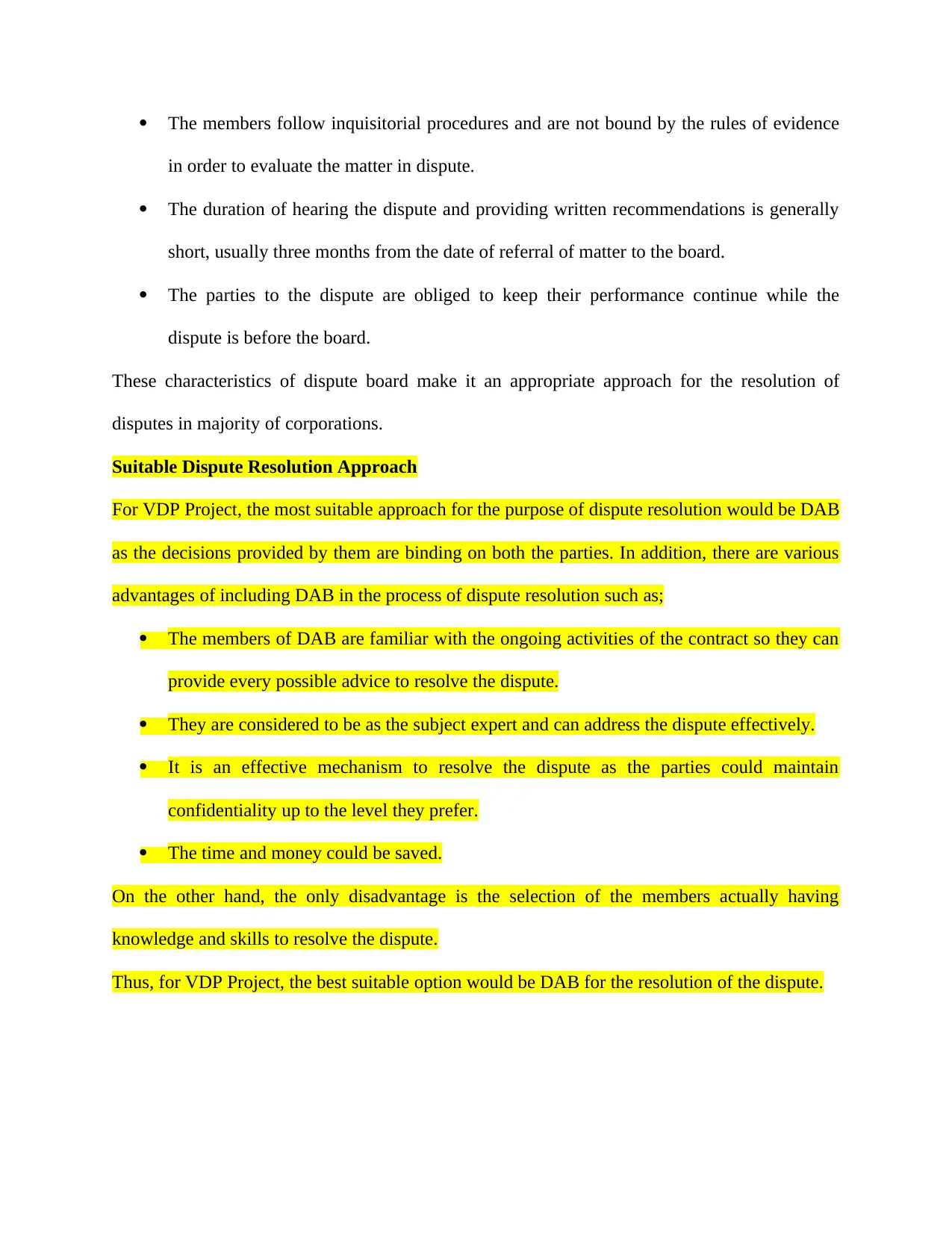
The members follow inquisitorial procedures and are not bound by the rules of evidence
in order to evaluate the matter in dispute.
The duration of hearing the dispute and providing written recommendations is generally
short, usually three months from the date of referral of matter to the board.
The parties to the dispute are obliged to keep their performance continue while the
dispute is before the board.
These characteristics of dispute board make it an appropriate approach for the resolution of
disputes in majority of corporations.
Suitable Dispute Resolution Approach
For VDP Project, the most suitable approach for the purpose of dispute resolution would be DAB
as the decisions provided by them are binding on both the parties. In addition, there are various
advantages of including DAB in the process of dispute resolution such as;
The members of DAB are familiar with the ongoing activities of the contract so they can
provide every possible advice to resolve the dispute.
They are considered to be as the subject expert and can address the dispute effectively.
It is an effective mechanism to resolve the dispute as the parties could maintain
confidentiality up to the level they prefer.
The time and money could be saved.
On the other hand, the only disadvantage is the selection of the members actually having
knowledge and skills to resolve the dispute.
Thus, for VDP Project, the best suitable option would be DAB for the resolution of the dispute.
in order to evaluate the matter in dispute.
The duration of hearing the dispute and providing written recommendations is generally
short, usually three months from the date of referral of matter to the board.
The parties to the dispute are obliged to keep their performance continue while the
dispute is before the board.
These characteristics of dispute board make it an appropriate approach for the resolution of
disputes in majority of corporations.
Suitable Dispute Resolution Approach
For VDP Project, the most suitable approach for the purpose of dispute resolution would be DAB
as the decisions provided by them are binding on both the parties. In addition, there are various
advantages of including DAB in the process of dispute resolution such as;
The members of DAB are familiar with the ongoing activities of the contract so they can
provide every possible advice to resolve the dispute.
They are considered to be as the subject expert and can address the dispute effectively.
It is an effective mechanism to resolve the dispute as the parties could maintain
confidentiality up to the level they prefer.
The time and money could be saved.
On the other hand, the only disadvantage is the selection of the members actually having
knowledge and skills to resolve the dispute.
Thus, for VDP Project, the best suitable option would be DAB for the resolution of the dispute.
Paraphrase This Document
Need a fresh take? Get an instant paraphrase of this document with our AI Paraphraser

Management of contract
In order to reduce the occurrence and impact of disputes on the project, the project should be
managed in an effective manner. The main causes of inter-organizational conflicts are task
interdependency, differentiation, opposing values, interests and objectives, communication
obstacle, tensions as well as personality traits. The occurrence of disputes might hamper the
performance of the employees so it requires being resolved as early as possible. In order to
reduce the occurrence and impact of disputes on the project, the management should include;
Well-planned and documented negotiations along with best practices in negotiations.
Clear and precise written contract.
Commitment to act in good faith, reasonably, honestly, as well as fairly.
Clear and effective communication between all and emphasis on maintaining
relationships
Dispute resolution clauses in written contracts.
In this manner, the occurrence of disputes could be prevented and the project could be managed
effectively.
References
Australian Capital Territory, 2004. Magistrates Court (Occupational Health and Safety
Infringement Notices) Regulations 2004. [Online] Available at:
http://www.legislation.act.gov.au/sl/2004-32/20040805-15690/pdf/2004-32.pdf [Accessed 7 May
2018].
Australian Disputes Centre , 2015. Overview. [Online] Available at:
https://www.disputescentre.com.au/dispute-board/ [Accessed 7 May 2018].
In order to reduce the occurrence and impact of disputes on the project, the project should be
managed in an effective manner. The main causes of inter-organizational conflicts are task
interdependency, differentiation, opposing values, interests and objectives, communication
obstacle, tensions as well as personality traits. The occurrence of disputes might hamper the
performance of the employees so it requires being resolved as early as possible. In order to
reduce the occurrence and impact of disputes on the project, the management should include;
Well-planned and documented negotiations along with best practices in negotiations.
Clear and precise written contract.
Commitment to act in good faith, reasonably, honestly, as well as fairly.
Clear and effective communication between all and emphasis on maintaining
relationships
Dispute resolution clauses in written contracts.
In this manner, the occurrence of disputes could be prevented and the project could be managed
effectively.
References
Australian Capital Territory, 2004. Magistrates Court (Occupational Health and Safety
Infringement Notices) Regulations 2004. [Online] Available at:
http://www.legislation.act.gov.au/sl/2004-32/20040805-15690/pdf/2004-32.pdf [Accessed 7 May
2018].
Australian Disputes Centre , 2015. Overview. [Online] Available at:
https://www.disputescentre.com.au/dispute-board/ [Accessed 7 May 2018].

Crepin, A. & Aversa, F., 2018. Construction and projects in Australia: overview. [Online]
Available at: https://uk.practicallaw.thomsonreuters.com/7-519-4527?
transitionType=Default&contextData=(sc.Default)&firstPage=true&bhcp=1 [Accessed 7 May
2018].
Gregory, M., 2014. Three Approaches to Dispute Resolution. [Online] Available at:
https://gregorymediations.com/three-approaches-dispute-resolution/ [Accessed May 2018].
The State of Victoria, 2017. Biodiversity management. [Online] Available at:
http://agriculture.vic.gov.au/agriculture/farm-management/business-management/legal-
information-for-victorian-landholders/biodiversity-management [Accessed 7 May 2018].
Victorian Government , 2017. Environmental effects of desalination plant.
Available at: https://uk.practicallaw.thomsonreuters.com/7-519-4527?
transitionType=Default&contextData=(sc.Default)&firstPage=true&bhcp=1 [Accessed 7 May
2018].
Gregory, M., 2014. Three Approaches to Dispute Resolution. [Online] Available at:
https://gregorymediations.com/three-approaches-dispute-resolution/ [Accessed May 2018].
The State of Victoria, 2017. Biodiversity management. [Online] Available at:
http://agriculture.vic.gov.au/agriculture/farm-management/business-management/legal-
information-for-victorian-landholders/biodiversity-management [Accessed 7 May 2018].
Victorian Government , 2017. Environmental effects of desalination plant.
⊘ This is a preview!⊘
Do you want full access?
Subscribe today to unlock all pages.

Trusted by 1+ million students worldwide
1 out of 12
Your All-in-One AI-Powered Toolkit for Academic Success.
+13062052269
info@desklib.com
Available 24*7 on WhatsApp / Email
![[object Object]](/_next/static/media/star-bottom.7253800d.svg)
Unlock your academic potential
Copyright © 2020–2025 A2Z Services. All Rights Reserved. Developed and managed by ZUCOL.


